
Julie Lluch’s work is as monumental as the pieces she sculpts. As one of the foremost living sculptors in the Philippines, Lluch has long exhausted the sensuality and grace in her chosen media. She’s molded poetry into terracotta, stone, ceramic, bronze, and, of course, Philippine indigenous clay for close to five decades now. Each piece she crafts is a conversation with the country’s feudal, colonial, imperial, indigenous, and feminist history. Her work outside the studio speaks for itself, too.
She’s been a long-time champion of the national feminist movement. Llunch founded the feminist group Katipunan ng Kababaihan para sa Kalayaan together with women writers, activists and intellectuals in 1983, and would also go on to establish the Kasibulan Women Artists Collective not too long after. What has driven her all these years are the complications of the Filipino identity.
Such dialogues have led her to examine Philippine history in a grand scale. Look around our outdoor spaces all over Manila, and we can find parks that are adorned with her gigantic bronze statues. Some of her most notable works include those of Arsenio Lacson, Le Marin, Ninoy Aquino, Evelio Javier, President Manuel L. Quezon, Cayetano Arellano, and José Abad Santos, among others. In 2008, the Cultural Center of the Philippines even honored her with her own retrospective. But she’s not slowing down anytime soon. Such is the struggle of the artist who wants to reflect the times.
Catching up with the artist in her studio.
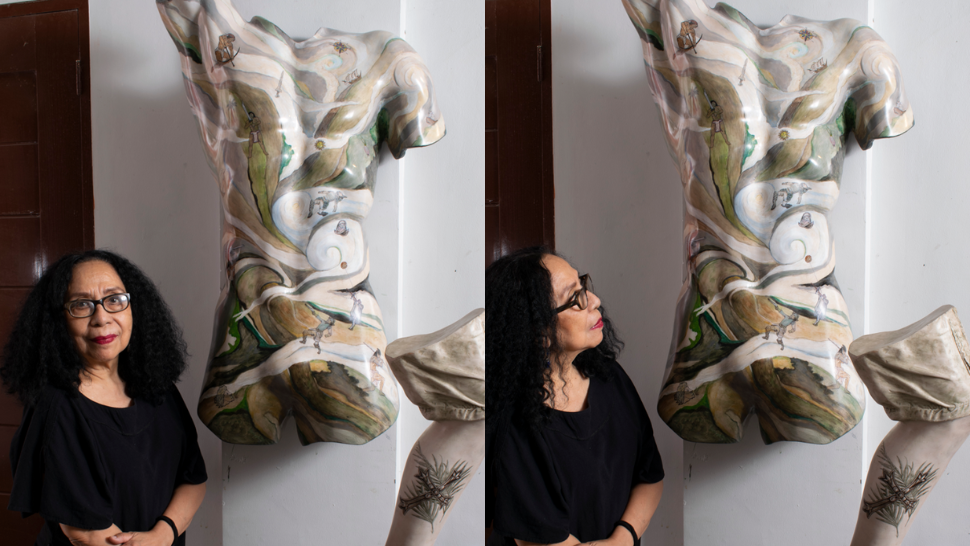
Twelve years later, in the 2020 Art Fair Philippines, the artist gave us one of her most memorable showcases yet in Irresistible Grace: In the Time of Plague. It was a recreation of Juan Luna’s “Spoliarium,” making sense of a panoply of historical and autobiographical life-sized figures. The exhibit was met with acclaim for how it spoke of the prevailing impunity in the country. It was classic Lluch, but viewed through a much more contemporary lens. The Iligan native has consistently found fresh modalities in the face of national and existential trial.
As a graduate of philosophy from the University of Santo Tomas, Llunch still can’t figure out how she’s made a career for herself in art. The self-taught sculptor is as earnest as they come in the art world. At the very least, that kind of background made her a different kind of artist. “I’m fortunate that I got to study Aristotle and Camus and Kierkegaard,” she tells us.
Lluch adds: “What do you do with a philosophy degree? Teach? I became a housewife and then I married my husband, who was a painter. I also wanted to paint. But then we thought, ‘No. Only one painter in the household.’ So I went into sculpting. There isn’t any creative rivalry at home. Sometimes I think that god really knows what he’s doing. If I did paint, I would’ve never become a sculptor!”
“Touch Me” (2023) and “Senor San Miguel” (2023) by Julie Lluch, Acrylic on Cold Cast Marble.

So what’s there left to do at this point? The modernist has seemingly done it all. Well, apparently, her latest exhibition with Galerie Stephanie has something to say about that. She enters previously uncharted territory here: painting. “This is the first time I tried to paint. So don’t call me a painter!”
Chronicles on Skin is made up of vignettes of the stories of our society. Lluch makes use of old casts from her previous exhibits, ending up in dismantled body parts to represent our struggle with bloodshed and tyranny. She presents the skin, through its imprints, as a conduit for conveying the social upheaval born out of the country’s brutal past, as well as of the current predicaments that we face. We can find ourselves looking at the cruel spectacle of a torn people. Llunch indulges us in her brand of mythmaking.
“Peasants Spoliarium” (2023) and “Sunrise (For Adi)” (2023) by Julie Lluch, Acrylic on Cold Cast Marble.
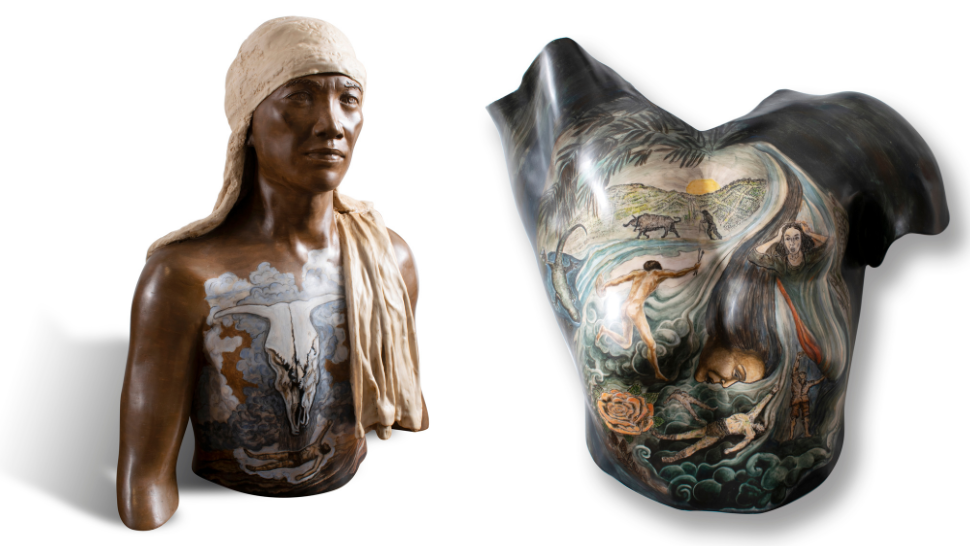
“I try because I want to tell stories. It’s the painting that carries the story. These figures are immovable. To me, this is a new challenge. It was either going to come out as a painted sculpture,” she claims. ” You can see the interplay of matter and form. And it came out like an undulating circus.
A circus, it is. Lluch thinks of this exhibit as an epic. By the looks of the dizzying narratives and stolid torsos and flexed limbs, we agree. “This is really a very personal and a very private expression,” she tells Esquire Philippines. “I think the dismemberment [of the figures] is still related to the violence in our recent and distant memory.”
“The Guerilla is a Poet (For Kerima)” (2023) by Julie LLuch, Acrylic on Cold Cast Marble.
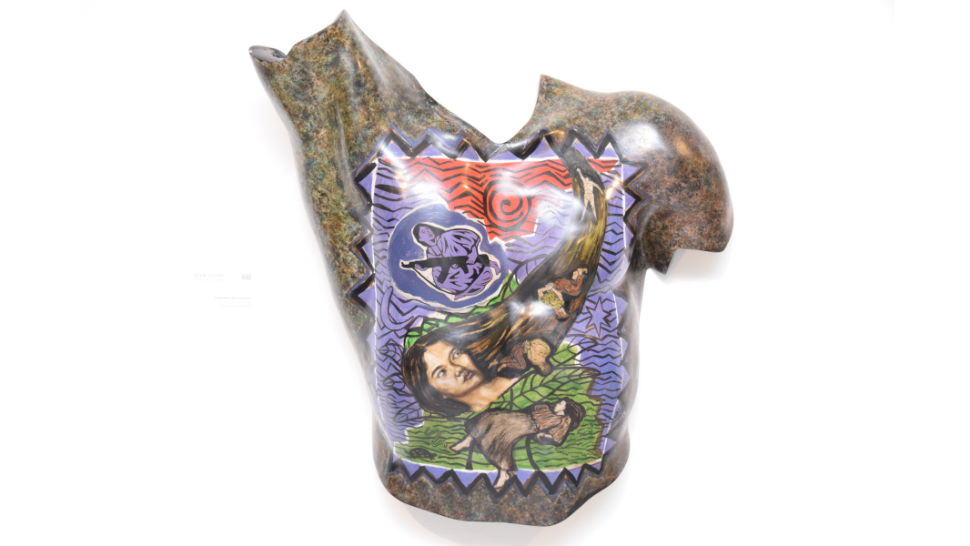
The artist takes us into an intimate look at her relationships, as well. In “The Guerilla is a Poet” (a title lifted from the late Joma Sison’s signature poem), we see women on the forefront of the fight for peace and freedom. This was done to honor the death of activist and poet Kerima Lorena Tariman, who died in 2021 after a clash between the New People’s Army and the Philippine military. “I still weep for her,” she says.
In another piece, aptly titled “Badi Grapiti (Para kay Erikson),” Lluch pays tribute to an old friend, National Democratic Front consultant Ericson Acosta. “When Ericson was in detention, he made these drawings. These are his na kinopya ko. It’s very simple. All these slogans and tattoos are from his experience.” Here, we are greeted with a sculpture with Acosta’s own scribblings and a picture of a man haunted by his own convictions. Of course, the good morning towel on the sculpture’s shoulder is a nice satirical touch, as well.
All these are created to do our freedom fighters justice. “This is the paradox: you’re dealing with something bloody and ugly but then you get this outcome, and it is beautiful,” she continues: “What is the role of the artist in times like these? The very function of art is to make the unbearable bearable.”
“EDSA Chronicles” (2023) and “Resistance” (2023) by Julie LLuch, Acrylic on Cold Cast Marble.
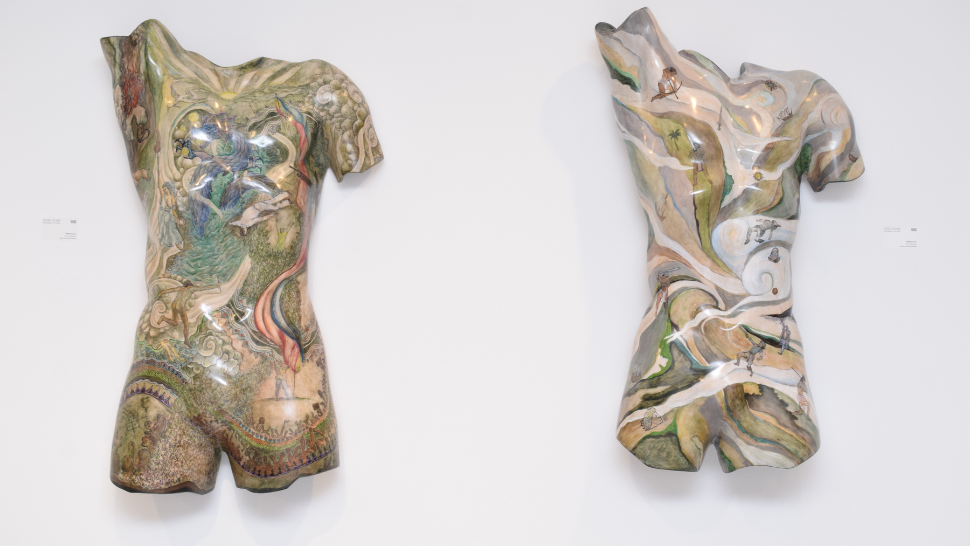
PHOTO BY GALERIE STEPHANIE.
The showcase puts us right in the middle of the entanglements that have divided the Filipino people. Other pieces touch on subjects like the lyricism of nationalist Adi Baen Santos, the gut-wrenching reality of the Lumad killings, and the imagery from the gory War on Drugs, as well as Magellan’s circumnavigation, the EDSA uprising, and, of course, “Spoliarium.” The exhibit invites us to engage with questions of identity and representation, with its triumphant colors and the fluidity of the forms. We can sense that the bodies here are poised in resistance, caught up in the pain of it all; and yet exude the essential qualities of freedom, self-determination, and survival.
Lluch’s work leads us to confront grim memories of injustice, political unrest, moral degradation, and inequality among our communities. These define the chaos and uncertainty artists like her face today. As writer Gabrielle Gonzales puts it, “Lluch’s trenchant storytelling pushes the boundaries of figurative sculpture and painting back against the repetition and revision of history, the decline of truth, and the erasure of cultural identity, amplifying many like voices from the margins of society.”
Chronicles on Skin also displays the artist’s “Georgia” series, a homage to her favorite artist Georgia O’Keefe, the collection’s namesake. “I lifted that from Georgia. Georgia is more famous for her flowers. The critics always referred to the sex. She was so angry!” she quips. We can see a much more evolved version of her style with these sculptures, where she hopes to capture the versatility of the medium once more. These ones speak of the potency of the human form, bonded by bolder and deeper hues. Here, we get Lluch’s ideas about the issues that surround gender.
“Picasso Luna Y Yo” (2023) and by Julie LLuch, Acrylic on Cold Cast Marble.
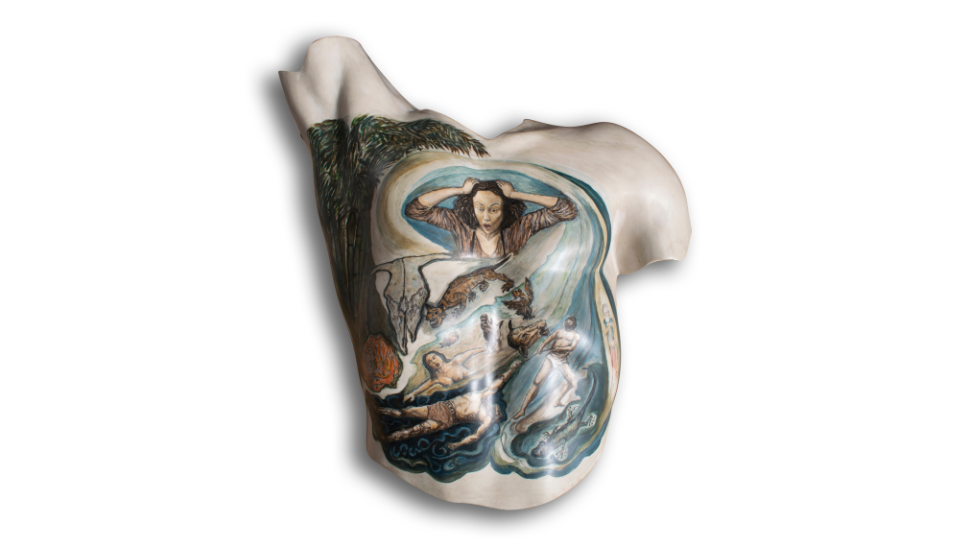
ome pieces from Lluch’s “Georgia” series.
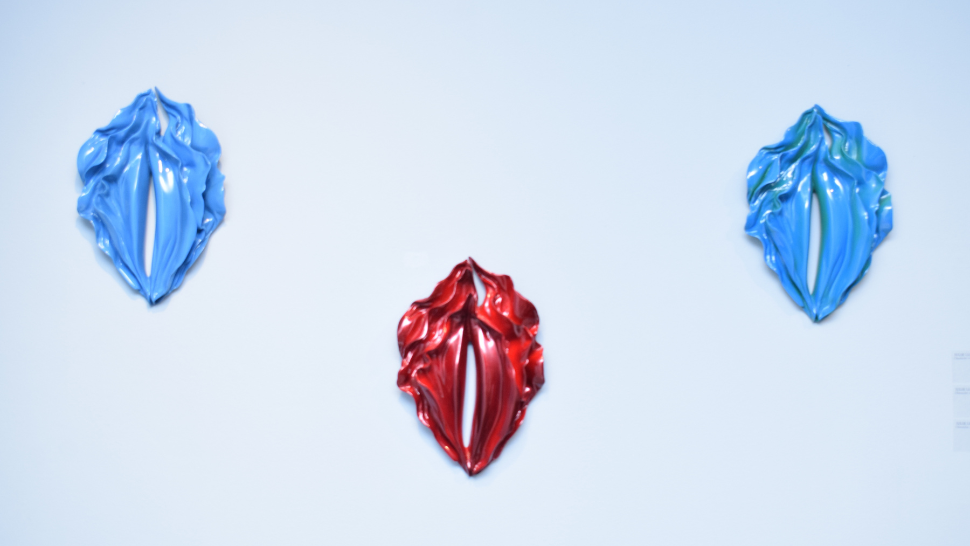
Right in the middle of it all, scattered around the dismemberment, are Lluch’s own images. Literally. We can find a picture of herself in quite a few of them, which she says, is part of the storytelling of this exhibit. “Historical and personal memory are weaved in and out. I put myself in it. I’m the one talking in this show. I’m the one expressing my anguish. This is work identifiable with me and that’s why I put myself in my own sculptures.”
As any great icon of modernity should, after all. Lluch is just as big a part of the blood-drenched tapestry of Philippine history as the next Filipino who dares to dream of a better nation. She is once such shaper of our realities. As she reflects on our society, Lluch is only elevated by the contradictions, legends, and cold truths in the collective struggle of the times. “Bakit ako kukuha ng iba?I’m a very bad painter. I don’t know how to draw. So ito na lang ang alam ko—the personal, the historical, the mythical, and the artistic all rolled into one.”
Chronicles on Skin by Julie Lluch will be on view until April 3, 2023. Galerie Stephanie is located on the 4th floor of Shangri-la Plaza East Wing, Mandaluyong City.
